10 Rome's best monuments
Rome is a treasure trove! If you are planning a getaway to the Italian capital, take note of the main monuments you should see during your visit.

Visiting the Plaza de España in Rome | ©Natasa Dav
Rome is a monumental city steeped in history, where strolling through its streets feels like walking through an open-air museum. Around every corner, you will find something amazing to see and marvel at.
If this is your first trip to the "Eternal City," this post will give you an overview of the 10 best monuments in Rome so that you know the most essential ones to include on your itinerary.
Let's get started!
1. The Roman Colosseum
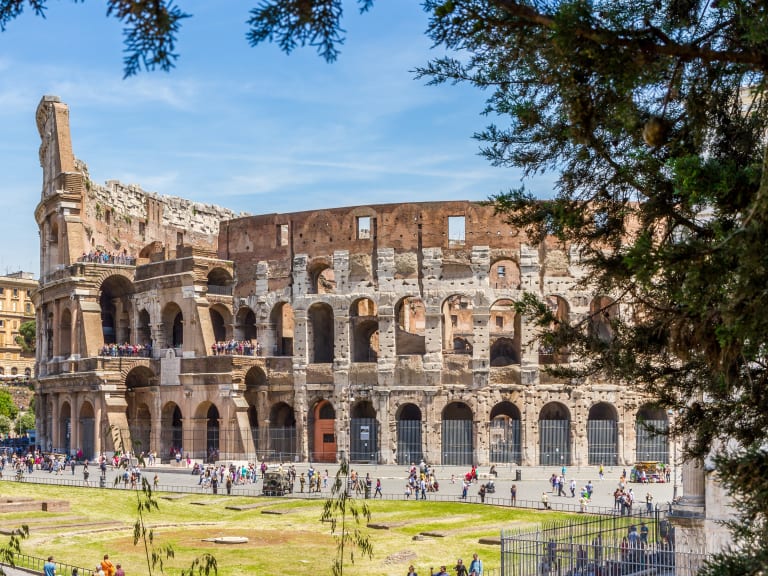
The Colosseum is Rome's most important monument and a symbol of the city. Around two thousand years old (which is easy to say), it is the largest amphitheatre built during the Roman Empire, with a capacity for 50,000 spectators. No other building surpassed this figure until the 20th century.
Its construction began in 72 AD during the reign of Emperor Vespasian and for more than five centuries it hosted a wide variety of shows: naval battles, gladiator fights, wild animal fights and public executions of prisoners, among others.
If its architecture is impressive from the outside, the interior of the Colosseum will not leave you indifferent. It is undoubtedly one of the best monuments in Rome, and to visit it without having to queue for ages at the entrance, I recommend the following options:
- Tickets for the Colosseum, the Roman Forum and the Palatine Hill—from €29
- Visit to the Colosseum, the Forum and the Palatine Hill—from €30
- Guided tour of the Colosseum and the arena with tickets to the Roman Forum and Palatine Hill—from €69
The last games held in the Colosseum took place in the 6th century AD and, despite suffering several fires, earthquakes and looting during the Middle Ages, this iconic monument continues to dominate the landscape of Rome.
Useful information
- Address: Piazza del Colosseo, 00184 Rome.
- How to get to the Colosseum in Rome: By underground, line B, Colosseo station.
2. St. Peter's Basilica

St. Peter's Basilica is the largest Christian church in the world and an important spiritual symbol for Catholics, as it was built over the tomb of St. Peter the Apostle (the first Pope in history), who was martyred in Rome and whose remains now rest inside.
In addition to being a religious icon, St. Peter's Basilica is also a masterpiece of the arts. Great artists such as Gian Lorenzo Bernini, Michelangelo, Giacomo Della Porta, Donato d'Angelo Bramante and Carlo Maderno participated in the project, and the work lasted for almost two centuries.
There is so much to see inside! To get to know it in depth and make the most of the experience, I recommend these options:
- Tickets to the dome of St. Peter's Basilica with audio guide—from €24
- Guided tour of St. Peter's Basilica and the dome—from €54
I recommend that you don't miss climbing to the dome of St. Peter's Basilica, as from up there you will have one of the best views of Rome.
Useful information
- Address: Piazza San Pietro, 00120. Vatican City.
- How to get there: By metro, line A, Ottaviano station.
3. The Sistine Chapel
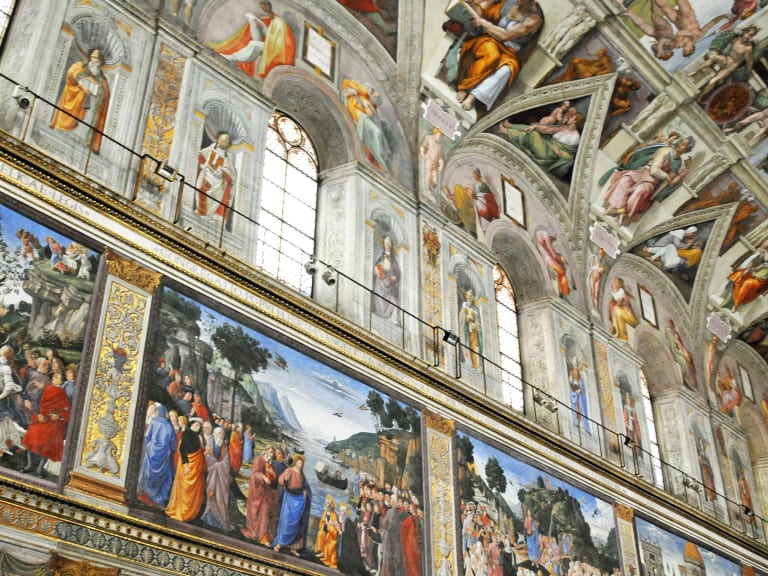
The Sistine Chapel is one of Rome's greatest Renaissance treasures and Michelangelo's masterpiece, despite his lack of experience in painting, as he considered himself a sculptor rather than a painter.
The commission from Julius II was a challenge for the artist, who spent ten years of his life decorating the vault and the wall behind the high altar, and the result is a marvel. However, other artists who also worked on this space were Botticelli, Perugino and Luca.
It is undeniable that this is one of the essential places to see in Rome during a trip! You will find the Sistine Chapel near St. Peter's Basilica, within the Vatican Museums. You can choose between:
- Skip-the-line tickets for the Vatican Museums and the Sistine Chapel—from €41
- Guided tour of the Vatican Museums, Sistine Chapel and St. Peter's Basilica—from €30
- Early morning guided tour of the Vatican and the Sistine Chapel—from €87
This is one of the chapels of the Apostolic Palace in Vatican City, where the official residence of the Holy Father is located. It is known not only for its spectacular decoration but also for being the place where popes are elected.
Useful information
- Address: Viale Vaticano, 51.
- How to get there: By metro, line A, Cipro-Musei Vaticani station.
4. The Trevi Fountain
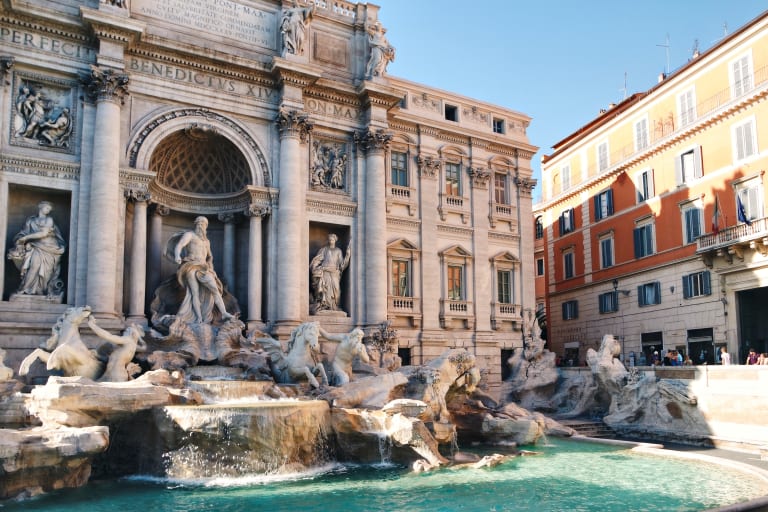
The Trevi Fountain is one of Rome's most famous monuments and, therefore, one of the city's most visited sites. The reason is simple: it is the most beautiful fountain in the world.
Its history dates back to the time of Emperor Augustus, when this fountain was the final section of the Aqua Virgo aqueduct built in the 1st century BC. However, the current fountain dates back to the 17th century and was commissioned by Pope Clement XII to the architect Nicola Salvi, who surprised everyone with this allegory of the ocean presided over by the god Neptune.
And it is something that has been happening for generations because when you look at the Trevi Fountain from the front, you will be impressed by the contrast between the small size of the square in which it is located and the monumentality of the fountain itself.
If you want to see it in all its splendour and avoid the crowds, I recommend visiting at a time other than midday or at the end of the day, as you are likely to encounter a swarm of tourists, or book a tour of Rome's fountains and squares.
Don't forget to follow the tradition of throwing a coin into the water so that fortune will bring you back to Rome.
Useful information
- Address: Piazza di Trevi. 00187, Rome.
- How to get there: By metro, line A, Barberini station.
5. The Pantheon of Agrippa
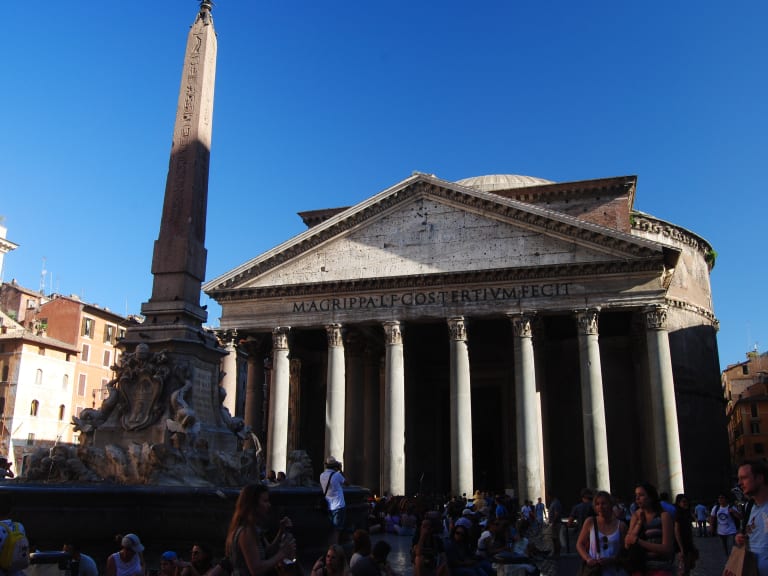
The Pantheon of Agrippa is one of the best monuments in Rome that you can visit, as it is the best-preserved building from Ancient Rome. This was possible because at the beginning of the 7th century, Pope Boniface IV transformed it into a church dedicated to Christians martyred during the persecutions.
This building dates back to the 2nd century AD and is one of the masterpieces of Roman architecture. The most outstanding features of the Pantheon of Agrippa are the precision and harmony of its construction and the central oculus in the dome, through which sunlight enters, giving the temple a unique atmosphere.
This monument is well worth a visit at any time of year, but I recommend taking a guided tour, especially on 21 June (during the summer solstice) to see the sunlight pass through the oculus perpendicularly, or on Pentecost Sunday when, after the 10:30 AM mass, a shower of red petals is thrown through the oculus in memory of the descent of the Holy Spirit upon the apostles. It's a beautiful sight!
In addition to being a church, the Pantheon of Agrippa is also a royal pantheon, as it houses the tombs of Vittorio Emanuele II, Umberto I and Margherita of Savoy, and even that of the Renaissance painter Raphael. You can choose from the following tour options:
Useful information
- Address: Piazza della Rotonda.
- How to get there: By metro, line A, Barberini station.
6. The Basilica of St. John Lateran
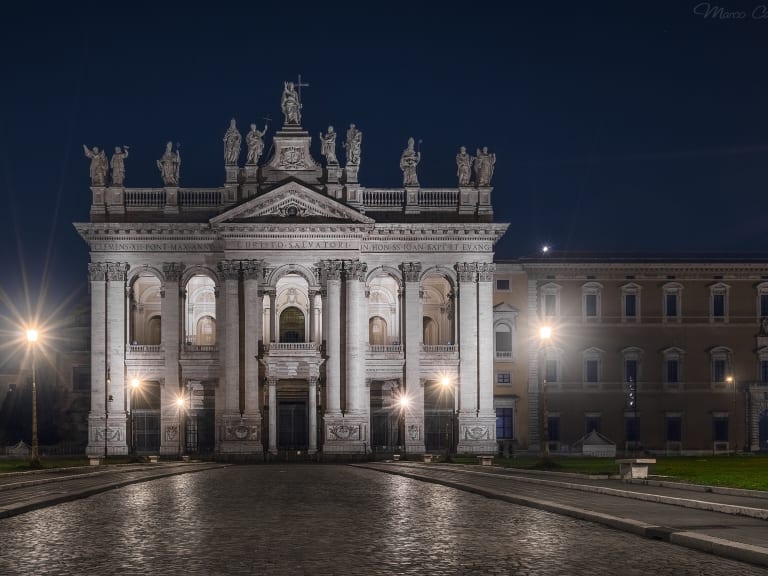
The Basilica of St. John Lateran is another of Rome's best monuments to visit, as it is a very special temple. Did you know that it was the first church to be built in the city back in the 4th century AD?
If there's one thing you shouldn't miss in the "Eternal City", it's visiting the catacombs and basilicas. Of the four major basilicas that exist, St. John Lateran is the most important of all. Not only because of its historical significance as the cathedral of Rome and the place where, until recently, all popes were proclaimed, but also because of the beauty of the basilica's interior.
You will be amazed by its size and the elegance of its chapels, the Cosmatesque cloister and the altar under a Gothic baldachin. You will also see surprising sites such as the Sanctuary of the Holy Stairs, the Chapel of the Holy of Holies** and the Palace **of the Lateran, which have a very interesting history within Christianity.
Useful information
- Address: Piazza di San Giovanni in Laterano, 4.
- How to get there: By metro, line A, San Giovanni station.
7. The Roman Forum
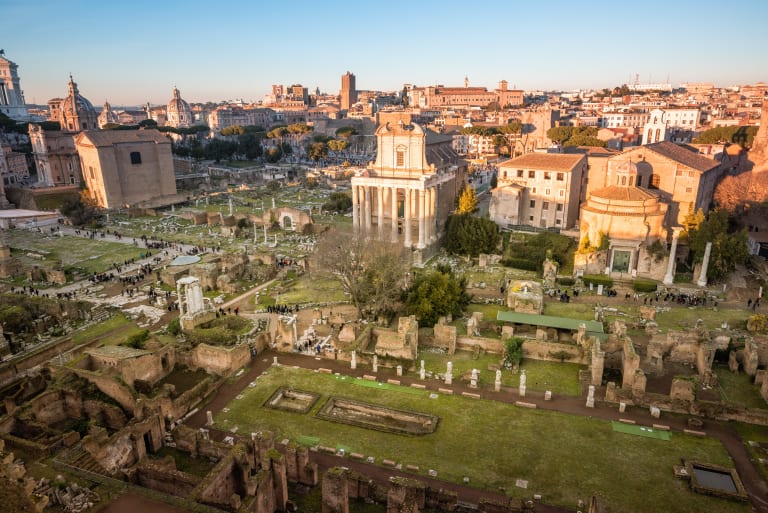
Next to the Colosseum you will find the Roman Forum, another example of Rome's finest monuments that will complete your view of Ancient Rome alongside other tourist attractions from the period such as the Pantheon of Agrippa, the Baths of Caracalla and the Flavian Amphitheatre itself.
The Roman Forum was the epicentre of public life during the Republic and the Empire. It is one of the most interesting sites in the city as it is full of temples, palaces, arches and other buildings that are generally in a good state of preservation. In fact, walking along the Via Sacra, you can imagine what Rome was like during its heyday more than 2,000 years ago. There is so much to explore here that I suggest the following options:
- Guided tour of the Colosseum, Roman Forum and Palatine Hill with optional arena—from 30
- Guided tour with priority access to the Colosseum, the Roman Forum and the Palatine Hill —from €79
- Tickets to the Roman Forum and Palatine Hill with multimedia experience—from €34
This is one of the essential visits to make in Rome and, as it is such a popular place, I recommend getting your tickets in advance to avoid the long queues of tourists that form at the entrances. In the post about tickets to the Roman Forum, you can find out how to get them so you don't miss a thing.
Useful information
- Address: Via della Salara Vecchia, 5/6, 00186 Rome.
- How to get there: By metro, line B, Colosseo station.
8. Castel Sant'Angelo
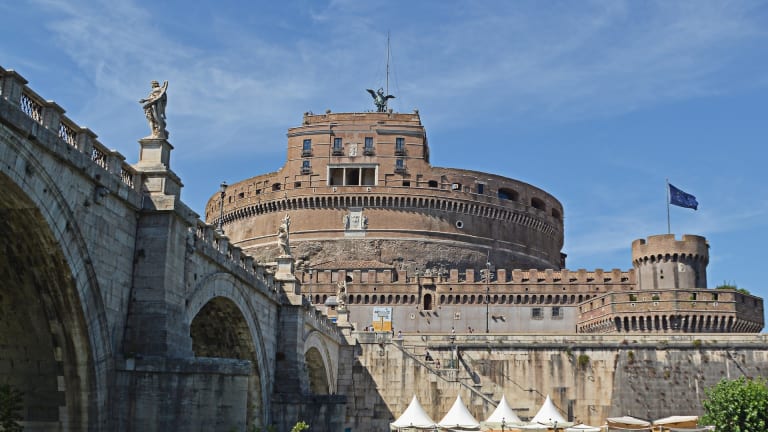
On the right bank of the Tiber River, a short distance from the Vatican, you will find Castel Sant'Angelo. A 2nd-century AD fortress designed by Emperor Hadrian as his family mausoleum, it eventually became a military building and a papal residence used in times of turmoil. Today, this monument houses the National Museum of Castel Sant'Angelo with a very interesting collection of paintings, sculptures, ceramics and period weapons.
To organise your visit, you can choose between:
- Skip-the-line tickets for Castel Sant'Angelo—from €30
- Tickets with audio guide for Castel Sant'Angelo—from €32
- Guided tour of Castel Sant'Angelo—from €55
- Express guided tour of Castel Sant'Angelo—from €49
I recommend buying tickets for Castel Sant'Angelo not only for its historical importance and the value of the museum's exhibits, but also because the terrace of the fortress offers one of the most beautiful views of the city, with the Tiber River, St. Peter's Basilica and the Sant'Angelo Bridge (one of the most beautiful bridges in Rome) on the horizon.
- Address: Lungotevere Castello, 50.
- How to get there: By bus, lines 23, 34, 49, 64, 87, 280, 492, 926 and 990.
9. The Catacombs of Rome
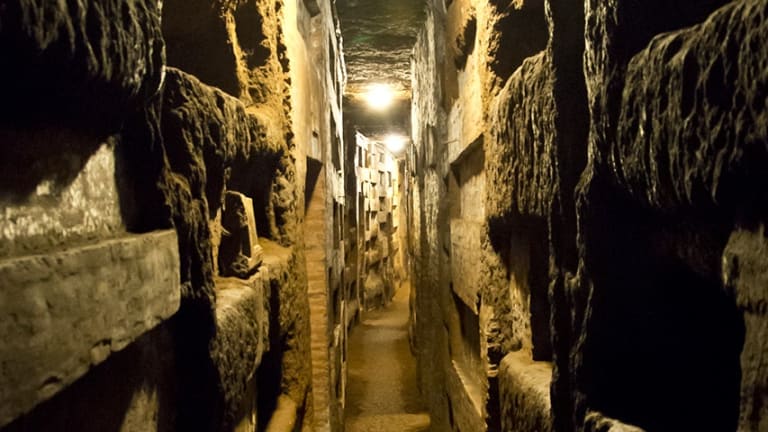
In Rome, there are more than sixty catacombs formed by hundreds of kilometres of underground galleries, which house thousands of tombs. In popular imagination, the catacombs were hiding places where the first Christians took refuge from imperial persecution, but in reality they were cemeteries where Christians buried their dead and only in very exceptional cases did they serve as occasional refuges for celebrating the Eucharist.
Of all the catacombs in Rome, only a few can be visited, specifically those of greatest historical interest, such as those of San Calixto, San Sebastián, Domitila (on the Via Appia) and Santa Inés or Santa Priscila (in the north of the city).
The catacombs of Rome can only be visited on an organised guided tour, as you will be travelling deep underground and the tunnels are quite narrow and dark. If you don't suffer from claustrophobia, this is one of the best monuments in Rome that I recommend visiting.
If exploring the catacombs of the "Eternal City" is one of the activities you definitely want to do during your trip, then I recommend reading the post about tickets for the Catacombs of Rome to find out how to get them, and don't forget the Vatican Catacombs!
Useful information
- Address: Various locations
- How to get there: To go to the Catacombs of San Calixto on the Via Appia, you can take bus line 118 from the Colosseo metro station (line B).
10. The Monument to Vittorio Emanuele II
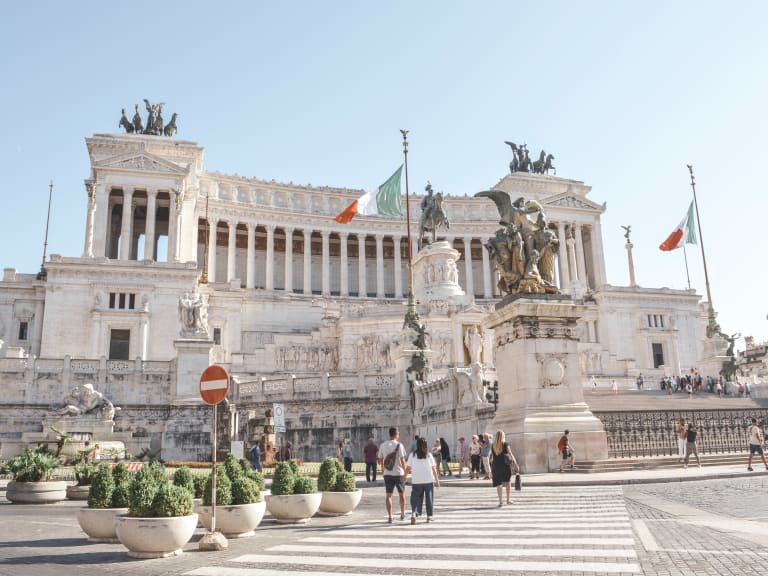
Popularly known as the "Vittoriale", the Monument to King Vittorio Emanuele II is a colossal white marble structure erected to honour the nation and the monarch after the reunification of Italy.
Interestingly, the monument was not initially popular with the Romans, who felt that its size and style did not fit in with the surroundings of Piazza Venezia. However, today it is one of Rome's most popular monuments among visitors.
Inside is the Central Museum of the Risorgimento, the Institute for the History of the Italian Risorgimento and the tomb of the unknown soldier, where an eternal flame burns in homage to those who fell for their country.
However, one of the biggest attractions of this monument for tourists, apart from its majestic appearance, is the panoramic view from the upper terrace (at the height of the quadrigas) of the Colosseum, the Imperial Forums, the Roman Forum, the Via del Corso and Trajan's Column. You won't be able to stop taking photos!
Useful information
- Address: Piazza Venezia
- How to get there: By bus, lines 30, 51, 83, 87, 160 and 170.
